Shrine of Haci Bektaş Veli Population: 5,300
Old name: Sulucakarahöyük
Festival: 16-18 August
Midway between Kırşehir and Gülşehir on the outskirts of Cappadocia, Hacıbektaş is home to the shrine of Hacı Bektaş Veli, a 13th-century Sufi thinker, originally from Khorasan in Iran, who arrived in what was then the village of Sulucakarahöyük some time between 1270 and 1280. Here he developed a philosophy emphasising the importance of science and reason, and permitting women an equal part in daily life. Images of Veli usually show him embracing a deer and a lion, an allegorical rendering of his teachings about peace and tolerance (other images show him with a pigeon, the guise in which he is said to have flown to Anatolia).
When he died in 1337 he was buried in the village, and as the influence of his writings spread, so the complex around his shrine grew. Today it is one of the most important pilgrimage sites in Turkey. Among the Alevis, the followers of Ali, a Muslim splinter group with perhaps 10 million adherents in Turkey, Veli is especially revered, and the festival forms one of the highpoints of their calendar.
Like Gallipoli, Hacıbektaş is one of those places that you really need to visit twice: once during the festival to soak up the atmosphere and again at another time when you will be able to look around in peace and quiet.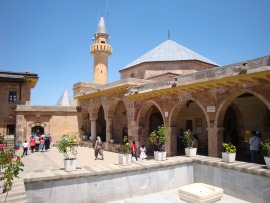
Shrine of Hacı Bektaş Veli
You approach the shrine (closed Mondays) via a gateway leading into a courtyard graced by a fountain with three water spouts and a carving of a six-sided star, the seal of Solomon. From this first courtyard a small gate leads to the main part of the complex, a cloistered space containing a large (and currently empty) pool.
Immediately to the right is a second lovely fountain, presided over by a carving of an amiable-looking marble lion which arrived from Egypt in 1853.
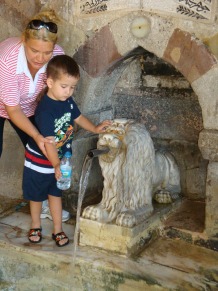 Two important buildings stand to the right of the courtyard. The first is the Aş Evi, or Cookhouse, which contains a number of outsize cooking pots, the most gigantic of them the Kara Kazan (Black Cauldron), which became very important to the Ottoman Janissaries, who would signal displeasure with a sultan by overturning a similar cauldron.
Two important buildings stand to the right of the courtyard. The first is the Aş Evi, or Cookhouse, which contains a number of outsize cooking pots, the most gigantic of them the Kara Kazan (Black Cauldron), which became very important to the Ottoman Janissaries, who would signal displeasure with a sultan by overturning a similar cauldron.
The second is a small mosque with a stubby minaret which was built in 1834 after Sultan Mahmud II had got rid of the Janissaries and closed the Alevi/Bektaşı lodges with which they were associated.
On the left-hand side of the courtyard stand a guesthouse, bathhouse and laundry. However, the most important room is the Meydan Evi, an Alevi “cemevi (gathering house)” where initiation and other ceremonies were carried out. Focal point of this room is a stove with a 15th-century painting of Hacı Bektaş Veli on the wall above it and a huge wooden throne beside it. Most impressive is the fine wooden ceiling whose nine separate layers represent the nine levels of the heavens.
A fine new museum explains Bektaşı beliefs and rituals and shows off costumes and religious paraphernalia.
A small corridor leads to the third courtyard where a bust of Atatürk commemorates the visit of the first president of the Turkish Republic to the town in 1919, on the eve of the War of Independence.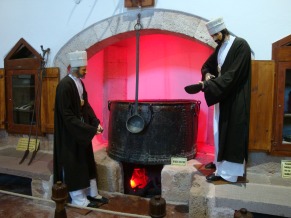
The third courtyard acts as a ceremonial approach to the heart of the complex, the shrine of Hacı Bektaş Veli. Here, steps lead down to a corridor whose floor is said to cover the remains of the architect Yanko Medyan, who became an adherent of Bektaşism after falling from the roof and calling out to Veli for help. To the immediate right of the steps is the oldest part of the complex, a small cell called a çilehane, or place of suffering, where the saint is thought to have spent long periods in seclusion.
An elaborately carved Selçuk-style portal leads through into the Kırklar Meydanı (Square of Forty Saints), a huge domed space which serves as a small museum, showcasing items associated with the Bektaşı dervishes, including fierce-looking ear-rings worn by unmarried men, begging bowls and a traveling picnic set.
On the wall hang some fine examples of the sort of calligraphy that elevates writing into pictures; in one particularly fine example a human face has been created out of the words for “Ya Allah, Mohammed, Ali”. The finest item on display is a 40-branched candlestick which was used in Bektaşı ceremonies.
A strikingly beautiful marble portal on the right-hand side of the door opens onto the room containing the shrine of Hacı Bektaş Veli. It’s known as Huzur-u Pir (the Presence of the Master), a particularly holy place where pilgrims will usually be praying.
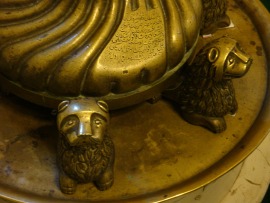 To the left of the main entrance and up some stairs is the tomb of Güvenç Abdal, described in the Velayetname, the biography of Veli, as the most beautiful girl in the world.
To the left of the main entrance and up some stairs is the tomb of Güvenç Abdal, described in the Velayetname, the biography of Veli, as the most beautiful girl in the world.
Also in the third courtyard, tucked away behind an ancient mulberry tree, is the tomb of Balım Sultan (1462-1516), who became the second most important leader of the Bektaşı order. It’s worth popping your head in here if only to see a second, even finer 40-branched candlestick, its base supported on brass lions, its body decorated with brass pigeons and dragons.
Around town
Once you’ve finished inspecting the complex, it’s easy to conclude that you’ve “done” Hacıbektaş which is not a particularly prepossessing place. In particular, the cultural centre that was inflicted on it a few years ago is an eyesore of a white elephant. Immediately behind it is the early 17th-century shrine of Bektaş Efendi. Nearby, the statue of Haçı Bektaş Veli was designed by the Derinkuyu-born sculptor, Hakkı Atamulu.
Otherwise, walk down towards the Belediye building, passing a long line of stalls that sell sometimes mystifying Alevi/Bektaşı paraphernalia in a sort of Turkish take on Lourdes in France.
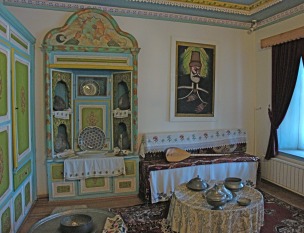 Across the road from the Belediye a house where Atatürk stayed in 1919 has been lovingly restored and boasts an especially gorgeous sitting room, with bench seats set up on either side of a table in a light-filled cumba (bay window). It’s well worth visiting.
Across the road from the Belediye a house where Atatürk stayed in 1919 has been lovingly restored and boasts an especially gorgeous sitting room, with bench seats set up on either side of a table in a light-filled cumba (bay window). It’s well worth visiting.
If you continue down the road behind the Belediye you will also come across the town’s last remaining kerpiç (adobe) houses, some of them centred on courtyards with porticos on each side, others with giant pots serving as literal chimneypots.
The restored Kadıncık Ana Evi (House of the Little Woman) behind the graceful Akpınar Çeşmesi (fountain), where Hacı Bektaş Veli is believed to have to stayed, should be open to the public but probably won’t be. It overlooks the Karahöyük (Black Tumulus) where the original settlement of Sulucakarahöyük stood from the Bronze Age until about the time of the birth of Jesus Christ. Finds from excavations on the hill are on display in the town’s small museum (closed Mondays).
Finally, if you visit the hillside Çilehane Park on the outskirts of town you will find many statues of famous bards and poets such as Yunus Emre (c.1240- c 321) and Pir Sultan Abdal (1480-1550) who are particularly revered by the Bektaşıs/Alevis. Here, too, is the Deliklitaş (Wishing Stone) with a hole in it through which (slim) people wriggle to make their wishes.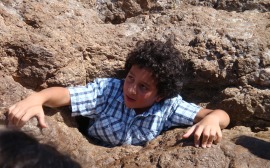
Sleeping
There’s very little accommodation in Hacıbektaş itself and most of it is pretty basic. Most people stay in Göreme, Avanos, Uçhisar or Ürgüp in central Cappadocia and visit on a day trip.
Ardıç Butik Hotel. Tel: 0533-246 5006
Cabbar Hotel. Tel: 0384-441 2981
Evrim Hotel. Tel: 0384-441 2900
Hünkar Otel. Tel: 0384-441 3344
Transport info
There are daily dolmuş services to Hacıbektaş from Kırşehir. Minibuses also leave from Nevşehir town centre from the top of the road running down to Forum Cappadocia- the journey takes an hour and transits Gülşehir.
Day trip destinations
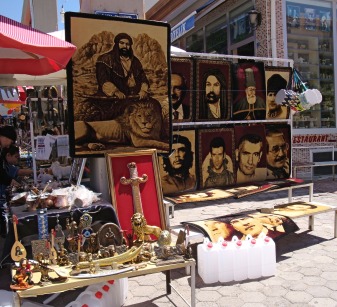 Street stall selling images of Ali, Hüseyin, Haci Bektaş Veli, Atatürk, Deniz Geçmis and other Alevi heroes
Street stall selling images of Ali, Hüseyin, Haci Bektaş Veli, Atatürk, Deniz Geçmis and other Alevi heroes
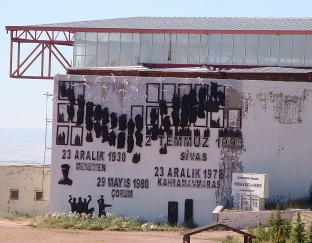 Remembering 20th-century massacres of Alevis
Remembering 20th-century massacres of Alevis


